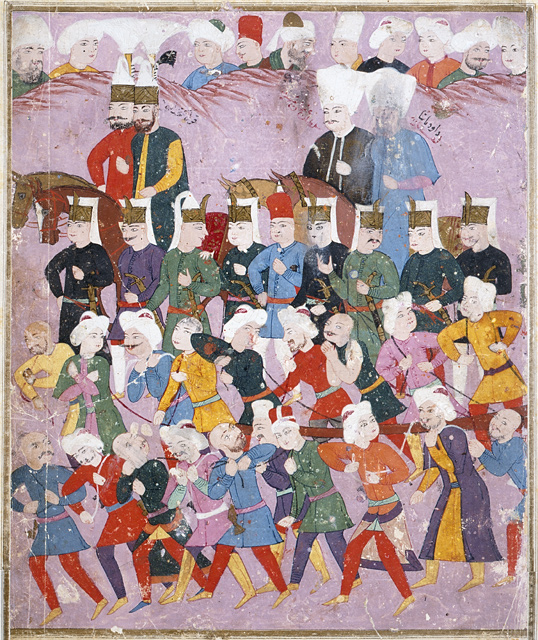What do a failed war by the Ottomans against the Hapsburg Empire, a rural rebellion in eastern Anatolia, the disappearance of the Roanoke colony, and near starvation at Jamestown, Santa Fe, and Quebec City have in common? They all take place during a period of global cooling known as the Little Ice Age, which brought extreme climate conditions, drought, heavy winters, and contributed to rising fuel prices, failing crops and massive civil unrest in places as diverse as North America and the Middle East.
Guest Sam White from Ohio State University makes the convincing argument that environmental and climactic factors are as influential in human history as economic, social, political, and cultural factors, and suggests a cautionary tale for human history as it enters another period of climate change.
Guests
 Sam WhiteAssociate Professor in the Department of History at the Ohio State University
Sam WhiteAssociate Professor in the Department of History at the Ohio State University
Hosts
 Christopher RosePostdoctoral Fellow, Institute for Historical Studies, The University of Texas at Austin
Christopher RosePostdoctoral Fellow, Institute for Historical Studies, The University of Texas at Austin
Your first book, which is called The Climate of Rebellion in the Early Modern Ottoman Empire, explores the far reaching effects of the severe cold and drought in the Middle East during the so-called Little Ice Age, and your current research looks at how New World settlement was affected during the same period. I want to start off by asking a really broad question: what is the importance of understanding climate and climate change in the broader field of world history?
That’s an excellent question. The importance is really twofold. One point is the importance of climate for history as history. Climate was something that past historians generally were not focused on, they were looking for political history, for social history, for economic history, really looking for everything but the environment. Environmental history as a field has really taken off over the past generation, that is to say, looking at ways that humans have changed the environment in the past, and the ways that environmental factors have affected the course of human history.
Climate, though, was not a large part of that discussion. There were some exceptions—I could name some important scholars of the past couple generations who have looked at it—but in the mainstream, even of environmental history, climate was not much considered. Now, though, with rising concern over global warming, climate is really starting to enter the picture. This is for two reasons. One is that historians, like all other people, have become aware of climate simply as a force in human affairs. Second is that, along with the rising concern over global warming, there has been a great deal more research into reconstructing past climates, so that we can know about climate much more than every before.
Now, with that greater understanding, we can see ways that climate fits into greater history in much more details and a much more convincing way than ever before. We can see how large scale climate changes have affected large scale developments, particularly in more extreme climates, particularly at the edges of settlement or agriculture, either in Arctic lands or deserts, and also in more particular short term ways as major climatic extremes have influenced the course of human events, as I discussed in my book about the Ottoman Empire. So, with that in mind, we can see climate really as an actor in history for really the first time.
The other part of this equation, too, is what does looking at the climate of the past—what does looking at the past experience of climate change help us understand about our current predicament, about how the world will face global warming now. Here, I have to say, we’re not going to give exact policy predictions. We can’t raise the bar too high, as it were. But, I do think there are wider lessons—wider parables, perhaps, that we can gather from looking at the experience of climate change in the past. With that in mind, we can look to see if there are bigger patterns in how people handle climate change and whether we can relate that to the present day.

A lot of your work—in fact, your first book and, in my understanding, your current research as well focuses on the period that is called the Little Ice Age. Chronologically, can you tell us when we’re talking about?
This is actually a really difficult question—
—(laughs) okay—
in fact, one that I tried to address in a recent article and some recent talks that I’ve given. The Little Ice Age in its broadest sense represents a period of global cooling that began around 1400 AD and ended around 1850 AD, but within that broad period of cooling there are a lot of regional variations and chronological variations. So, in other words, some parts of the world, particularly the far north, start to cool a little bit earlier, perhaps as early as the late 1200s or early 1300s. Other parts of the world, particularly the Southern hemisphere, really didn’t start to cool until almost a century after that. And, in terms of the end of the Little Ice Age, it’s also quite difficult because, even within the broader patterns of climactic change over generations or centuries, we also have particular episodes of more extreme change produced by, say El Niño and La Niña events, and volcanic eruptions which can produce more exceptional cooling.
So, I guess in the end, how we define it may also reflect in what we’re interested in learning, what part of the world we’re interested in studying, and where we also see the beginnings of global warming, which, in some respects, is the end of the Little Ice Age.
Alright, so in terms of getting more specific so that we can look, perhaps, at the tangible effects of this period, your first book focused on the Little Ice Age and its impact on the Ottoman Empire. I understand that it’s going to be impossible for you to try to sum up your research in the next ten minutes that we have remaining in the interview, but … what things happened in the Ottoman Empire that we can attribute to the Little Ice Age, and what were the effects of those?
So, the research, and the story in my first book, focuses on a period of really acute crisis that began in the 1590s. Within the broader context of the Little Ice Age in the Ottoman lands, in the Near East, the late 1400s and early 1500s, when the empire enjoyed some of its most rapid expansion, were relatively stable, relatively mild times for climate. Starting around the 1560s, you start to see a number of episodes of more severe winters and more severe and prolonged droughts, which start to have an impact on the subsistence of the Ottoman peasantry and the wider provisioning systems that the empire used to supply its major cities, especially the capital, Istanbul, and its army.
In the 1590s these pressures really turn into crisis. What happens is that the empire enters into the longest drought in that region in probably the past six centuries. This leads to significant famine in parts of the empire, especially in the semi-arid parts of Anatolia, Northern Syria, Northern Iraq, where there’s very little agricultural diversification and a lot of vulnerability to this sort of drought. But what actually tips this natural disaster into a bigger human crisis are two more contingent factors. One is that, in 1593, in the midst of this drought, the empire winds up getting into a very long war with the Habsburg Empire, which is actually known—sort of uncreatively—as “The Long War.” This stretches on for more than a decade and drains a lot of resources, and really keeps it from handling problems in its interior, and, at the same time, drives the empire to heavy taxes and requisitions from an already starving peasantry.

The other contingent event, which was something even more remarkable that I ended up finding, was that the extreme cold and drought didn’t only have its toll on people, but on the Ottoman livestock. There was a huge epizootic—that is to say, epidemic disease—among the sheep and cattle in the Ottoman empire, in some cases wiping out 90-95% of flocks and herds across Anatolia, the Balkans, even into Crimea. With that, it really aggravates this famine, and it really aggravates the supply problems for the military fighting the Habsburgs along the frontier. So, the successive sultans are forced to make ever more heavy demands on an already overburdened peasantry to try to keep up this supply of animals which are vital for supplying the army on the Habsburg frontier. And it’s these especially heavy demands that seem to be a tipping point for a rebellion, known as the Celali Rebellion, which would later leave parts of the Ottoman Empire devastated in following decades.
This ecological and human crisis is something that the Empire takes an enormously long time to recover from. It really exposes a lot of these deep-seated problems that the empire had with its provisioning and requisitioning systems, and is sort of a tipping point ecologically as well. As the violence and famine drive flight from the countryside to cities, as nomadic and semi-nomadic pastoral tribes begin to invade from the eastern edge of empire, and the whole economic and agrarian structure of the empire really begins to change, feeding what ends up becoming generations of political crisis.
You mentioned that this drought—how long did it last? It started in the 1590s…?
It lasts about five to six years of continuous drought, and the duration is especially important. Essentially a year or two of drought is something that peasants in a region like Anatolia would have adapted to after centuries of experience. But, each year that a drought continues, essentially a poor peasantry is going to use up all of its alternative resources. They’ll first tap into whatever reserve grains they’ve set aside, perhaps even use up their seed crop for the following year, perhaps find whatever they can to sell, devour whatever livestock they might, but as a drought goes on for year after year, those resources get used up. In the end, the only alternative is flight, starvation, or in some cases turning to violence and banditry.
For an historian like yourself, who works on climate change, how do you make the link between successive years of drought and climate change when you’re going back through the records, because I imagine it’s very difficult to reconstruct these things from an historical standpoint?
So, the central insight of the book really came about, by and large, by accident. I had not started off to write a book about climate in the Ottoman Empire, I had started off trying to answer other questions about the environmental history of the Middle East. I was trying to address an age old question about whether the Middle East had entered into an environmental decline, whether it suffered from long term acidification or desertification as a result of changing land use. This is sometimes imagined for the Middle East.
What caught my attention, though, was new data coming out from climate studies. This is by and large because of interest in global warming. Climatologists were trying to reconstruct past trends to see if there were present implications from a warming climate. And, looking through those climate reconstructions I came across this tremendous fact that this longest drought in the Empire’s history happened to take place just before this giant rural rebellion broke out. I figured the two were probably not a coincidence and, even if they were, it was certainly worth studying in more depth and, once I started to pursue that line of questioning, it really became the subject for a completely new book.
As I performed the research, it really was a great deal of fun. It came together like the pieces of a detective story. At first, I had this large coincidence, this puzzle to solve. And one by one as I looked through various sources that I turned to for this project, which included certain registers from the Ottoman archives, as well as dispatches from Venetian ambassadors and contemporary European and Ottoman chroniclers, I learned one piece of the story at a time. I learned about the timing of the outbreak of the rebellion, where it occurred, I learned about the disease of livestock and, eventually, about the particular large scale order for sheep that really tipped off the rebellion. One by one, the various pieces of the puzzle fell into place. Then I spent the rest of my time trying to make sure that the whole story did indeed fit together, that there was corroborating evidence and, of course, that there was no contradictory information from other sources.
Your new project is looking at pretty much the exact same period, in terms of how New World settlement was impacted. I realize this is an ongoing project, but can you share with us some of the things that you’re finding?
This is a project that I think will be a lot more familiar to many listeners insofar as certain pieces of this puzzle are already well known. The central insight that has come from past climate research, again, mostly tree ring based drought reconstructions is that the settlers in Roanoke and Jamestown happened to arrive during probably the two worst droughts at those particular sites in the past 700 years. Not coincidentally, both settlements faced starvation, disease, and, in the case of the Roanoke settlement it disappeared, and, in the case of the Jamestown settlement, it very nearly did if not for some very extraordinary coincidences and very timely rescue of the colony by supplies coming from London.
What I wanted to do was look at the story in more detail and put it into wider context. The Jamestown settlement was not necessarily the first attempt to settle North America. I wanted to see if both contemporary settlements—Santa Fe and Quebec were founded almost exactly the same year—as well as earlier Spanish settlements had also come up against similar difficulties from the climate. And what I found is that they did, and they were all, in fact, extraordinarily unlucky. But there was more than just bad luck involved.
On the one hand, there was more than just the climactic factor. This was also an age of particularly pronounced global cooling during the Little Ice Age, stretching from the late 16th to the early 17th century. And also, all of these European colonists, whether Spanish, English, or French, came in with certain basic misconceptions of the American climate. They really did not understand the difference between the continental climate of North America, vs the maritime climate of Europe, or the difference in seasonal rainfall patterns between, say, the Mediterranean region and American lands at the same latitudes. They really carried forward with the Classical idea of “climes,” as they call them, this idea that lands along the same latitude should have similar environments.
Simply put, this is not true. And, in fact, the puzzle is particularly interesting when we consider just how different sometimes the same climates are at different latitudes. I think Americans and Europeans often forget how far north Europe is vis a vis America. Even Newfoundland is entirely to the south of England. There were pamphlets regarding the early efforts to settle in Newfoundland which go back to the 1580s worrying about whether it would be too hot because it was entirely to the south of England. So, if we imagine where Virginia is, that’s down around Sicily, much less, say Austin which would be around Alexandria, Egypt.
There’s a very different line up to where these countries fit geographically, which I think we take for granted because we’re more familiar with present day climates, but European settlers were not, and they came over expecting something very different than what they found.
And they ran right into this period of global cooling, right around the turn of the 17th century, right around 1600.
Yes.
Editor’s note: Audio of a full lecture by Dr. White on the topic of this podcast can be accessed here.